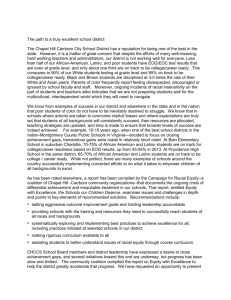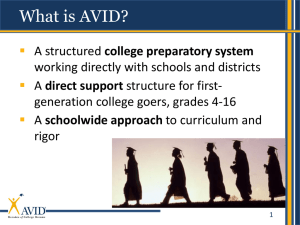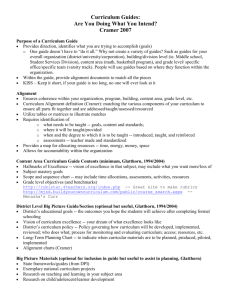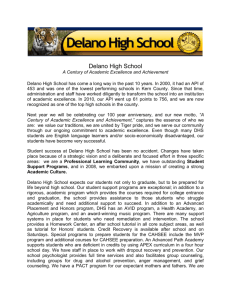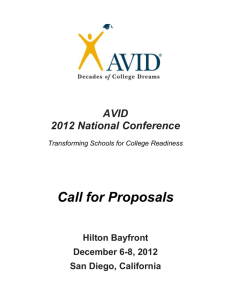Teaching practices from America`s best urban schools
advertisement
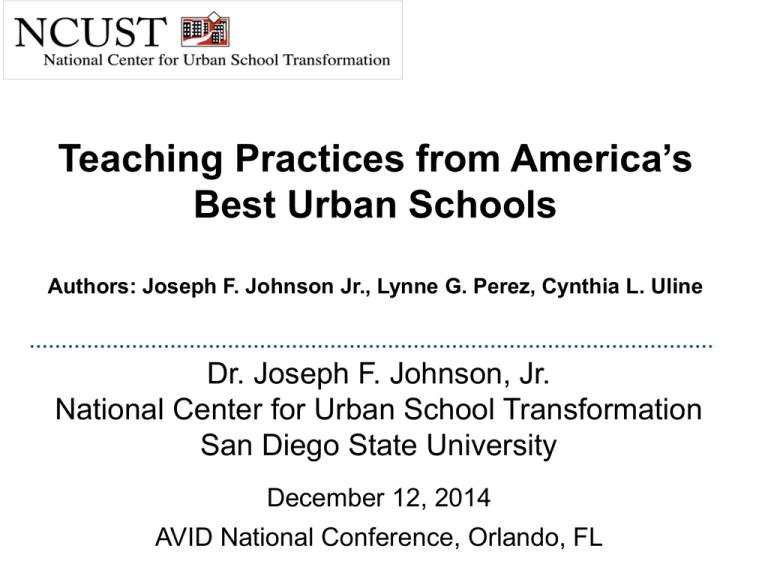
Teaching Practices from America’s Best Urban Schools Authors: Joseph F. Johnson Jr., Lynne G. Perez, Cynthia L. Uline Dr. Joseph F. Johnson, Jr. National Center for Urban School Transformation San Diego State University December 12, 2014 AVID National Conference, Orlando, FL Excellence & Equity Are Attainable! • There are outstanding schools that defy stereotypes and trends: Schools where every demographic group achieves at high levels on multiple measures. • In particular, there are schools where every demographic group served achieves proficiency at higher rates than the state average for all students. • NCUST has studied and awarded 76 impressive schools that exemplify both equity and excellence. Equity without excellence is just mediocrity. Excellence without equity is an oxymoron. 2 The Center sponsors the National Excellence in Urban Education Award Program, annually identifying some of the nation’s highest performing urban elementary, middle, and high schools, and alternative schools. Since 2006, we have awarded 92 schools from 21 states. Many of these schools have featured AVID. Instruction Makes a Difference • In high-performing urban schools, many factors influence student success. • The quality of instruction, however, is a key factor in influencing student success rates. • This session will focus upon eight instructional practices that we find frequently in high-performing urban schools. 4 Focusing on Mastery • Jointly committing to ensuring that every student learns specific concepts or skills in each lesson • Ensuring that all students will have a high likelihood of learning rigorous standards (guaranteed curriculum) • Attending to depth of understanding vs. coverage of a multitude of standards (viable curriculum) • Before instruction begins, deciding what mastery should look like • Not just posting an objective, but being objective-driven, relentlessly 5 Teaching Clearly, Logically, and Concisely • Determining what students need to understand in order to attain mastery • Anticipating student misconceptions (planning ahead) • Avoiding long lectures • Teaching thinking strategies, note-taking skills, graphic organizers, and research skills so students will be able to access information when they need it • Scaffolding learning experiences • Teaching students to use rubrics to guide their work 6 Checking for Understanding • Frequently checking to determine what students understand (using oral, written, and non-verbal strategies) – continuously assessing! • Requiring feedback from all students • Using small group instruction to maximize opportunities to check for understanding • Using student feedback to refine instruction • Engaging in continuous formative assessment • Refusing to allow students to fall behind • No chicken feeding 7 Building Essential Vocabulary • Pre-identifying the lesson vocabulary that will be the gatekeeper to understanding • Assuming that much of the “teacher vocabulary” associated with a lesson needs to become part of students’ spoken vocabulary • Providing students plentiful opportunities to use the key vocabulary in original sentences with confidence • Helping students “talk math,” “talk science,” and “talk other disciplines” (explain, describe, relate, justify, teach, etc.) so that teachers know how students are understanding concepts. 8 Providing Appropriate Practice • Assigning work that students are likely to complete successfully (Gradual release of responsibility: I do, we do, you do WHEN I know you are likely to do it well) • Instructing more/assigning less • Differentiating assignments (including homework) • Employing grading policies that encourage students to strive toward mastery • Monitoring student completion of assignments • Stopping assignments when student work indicates that more instruction is needed 9 Connecting Students to Content • Knowing students well • Tapping into student motivations, interests, backgrounds, prior knowledge, culture • Using culture/background as a tool to teach rigorous academic content • Helping students perceive the foreign as familiar • Making academic concepts REAL for students 10 Helping Students Feel Valued & Respected • Demonstrating courtesy and respect in all interactions • Expressing a genuine interest in each student’s ideas • Maintaining a classroom that instills pride in students • Expressing a genuine interest in each student’s ideas • Demonstrating that the content students are being taught will lead them to post-secondary education and worthwhile opportunities • Posting high-quality student work frequently 11 Leading Students to Love Learning • Demonstrating enthusiasm and helping students understand the importance of the content to be learned • Providing opportunities for students to use technology and/or manipulate objects to reinforce lesson objectives • Integrating other disciplines to teach lesson objectives • Providing students leadership opportunities • Encouraging student-to-student interaction 12 Great Schools Make These Practices Commonplace HOW DO THEY DO IT? 13 Building Collaboration and Trust • Creating a culture in which teachers feel they are part of a team focused upon supporting each other as they help students master critical learning goals How can you, as an AVID leader, influence collaboration so that your colleagues are more likely to be objective-driven, avoid chicken feeding, promote ownership of lesson vocabulary, provide appropriate practice, and make lessons engaging? 14 Making Teaching Public • Ensuring that administrators observe classrooms frequently and provide constructive feedback • Ensuring that teachers observe each other’s classrooms frequently and provide constructive feedback How can you, as an AVID leader, model openness and encourage critique of your work as you try to demonstrate effective instructional practices? How can you support your colleagues as they work to improve the effectiveness of their instruction? 15 Persisting • Keeping focus on the real goal: changing students lives • Celebrating progress and small victories regularly • Visiting and collaborating with positive educators who achieve outstanding results for diverse populations of students (See www.ncust.org.) How can you, as an AVID leader, help your colleagues keep their eye of the prize: excellent educational outcomes for every student? 16 Learn more at our annual symposium on high-performing schools May 20, 21, & 22, 2014 Dallas, Texas Register now at: http://www.ncust.org Resources Johnson, J.F., Perez, L.G., & Uline, C.L. (2012) Teaching practices from America’s best urban schools: A guide for school and classroom leaders. Larchmont, NY: Eye on Education Dufour, R. & Marzano, R. J. (2011). Leaders of learning: How district, school, and classroom leaders improve student achievement. Bloomington, IN: Solution Tree. Gay, G. (2010). Culturally responsive teaching: Theory, research, and practice (2nd ed). New York: Teachers College Press. 18
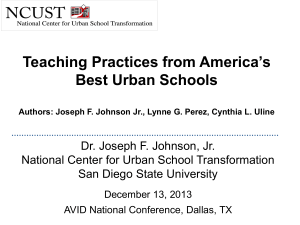
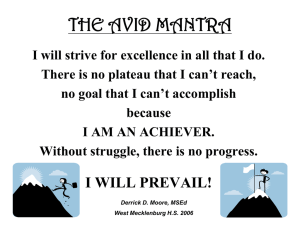
![avid parent night 1[1].](http://s2.studylib.net/store/data/005364026_1-3545164f7508a237d75956b3943e7277-300x300.png)

